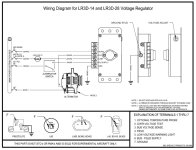WingnutWick
Well Known Member
Installing a new B&C alternator and the instructions say “Take care to route the (alt output) wire separately from the field connector assembly”. Is this read as don’t run the two wires together or just clear from the connector assembly that plugs into the alternator? The previous setup had the two wires running together and I’m wondering if this was wrong?
Thanks all!
Thanks all!







